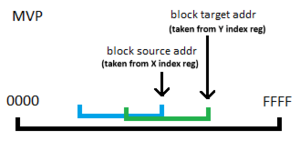We've just updated MediaWiki and its underlying software. If anything doesn't look or work quite right, please mention it to us. --RanAS
MVP: Difference between revisions
From SnesLab
(linkify flags) |
(→External Links: Labiak page number) |
||
| Line 59: | Line 59: | ||
=== External Links === | === External Links === | ||
* [[Eyes & Lichty]] page on MVP: https://archive.org/details/0893037893ProgrammingThe65816/page/n494 | * [[Eyes & Lichty]] page on MVP: https://archive.org/details/0893037893ProgrammingThe65816/page/n494 | ||
* [[Labiak]] page on MVP: https://archive.org/details/Programming_the_65816/page/n164 | * [[Labiak]] page 154 on MVP: https://archive.org/details/Programming_the_65816/page/n164 | ||
* snes9x implementation of MVP: https://github.com/snes9xgit/snes9x/blob/master/cpuops.cpp#L3077 | * snes9x implementation of MVP: https://github.com/snes9xgit/snes9x/blob/master/cpuops.cpp#L3077 | ||
* undisbeliever on MVP: https://undisbeliever.net/snesdev/65816-opcodes.html#mvp-block-move-previous | * undisbeliever on MVP: https://undisbeliever.net/snesdev/65816-opcodes.html#mvp-block-move-previous | ||
Revision as of 04:38, 5 December 2023
| Basic Info | |||||||
|---|---|---|---|---|---|---|---|
| Addressing Mode | Opcode | Length | Speed | ||||
| block move | 44 | 3 bytes | 7 cycles per byte moved | ||||
| Flags Affected | ||||||||
|---|---|---|---|---|---|---|---|---|
| N | V | M | X | D | I | Z | C | |
| . | . | . | . | . | . | . | . | |
MVP (Block Move Positive) is a 65c816 instruction that copies a contiguous block of memory. It is intended to copy a block from a lower address to a higher address (moving it in the positive direction).
In Eyes & Lichty, the "P" in the mnemonic stands for "Previous" not "Positive."
Parameters
- the X index register specifies the ending (highest) source address of the block
- the Y index register specifies the ending (highest) destination address of the block
- the C double accumulator specifies the length of the block in bytes minus one
- the first operand byte specifies the destination bank the block will be in
- the second operand byte specifies the source bank the block starts out in
Execution Sequence
The following loop is repeated until the value in the C double accumulator is $FFFF:
- one byte is copied from the address in X to the address in Y
- both X and Y are decremented
- C is decremented
See Also
External Links
- Eyes & Lichty page on MVP: https://archive.org/details/0893037893ProgrammingThe65816/page/n494
- Labiak page 154 on MVP: https://archive.org/details/Programming_the_65816/page/n164
- snes9x implementation of MVP: https://github.com/snes9xgit/snes9x/blob/master/cpuops.cpp#L3077
- undisbeliever on MVP: https://undisbeliever.net/snesdev/65816-opcodes.html#mvp-block-move-previous


